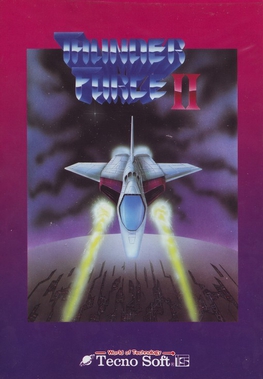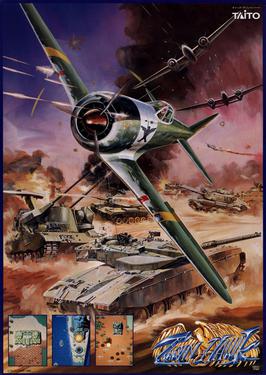
Zero Wing is a 1989 side-scrolling shooter arcade video game developed by Toaplan and originally published in Japan by Namco and in North America by Williams Electronics. Controlling the ZIG space fighter craft, players assume the role of protagonist Trent in a last-ditch effort to overthrow the alien cyborg CATS. It was the eighth shoot 'em up game from Toaplan, and their fourteenth video game overall.

Asmik Ace, Inc., formerly Asmik Ace Entertainment, Inc. is a Japanese film production and distribution company. In the past, the company has distributed video games. It was formed in 1997 through a merger between the Asmik Corporation and Ace Entertainment, both in Japan. The name Asmik comes from its three founding companies: Ask, Sumitomo and Kodansha. The company is headquartered on the third floor of the Lapiross Roppongi building in Minato, Tokyo, and is a wholly owned division of Jupiter Telecommunications (J:COM).

Raiden is a 1990 vertically scrolling shooter arcade video game developed by Seibu Kaihatsu and published by Tecmo in Japan. The game's story takes place in the year 2090, when an alien species known as the Crystals invaded Earth. Players assume the roles of the Vanquish Crystal Defense pilot duo, taking control of two state of the art Fighting Thunders aircraft to defeat the Crystals and save the Earth.

Truxton is a 1988 vertically scrolling shooter arcade video game originally developed by Toaplan and published in Japan and Europe by Taito, as well as in North America by Midway. Set in a future where the Gidans alien race led by Dogurava invaded the fictional planet Borogo, players assume the role of fighter pilot Tatsuo taking control of the Super Fighter ship on a last-ditch effort to overthrow the alien invaders.

Thunder Force II is a scrolling shooter developed by Technosoft. It was first released in Japan on October 15, 1988 for the X68000 computer. A year later, it was ported to the Sega Mega Drive/Genesis game console and released in Japan, Europe, and the United States. Thunder Force II was one of the six launch titles for the U.S. Genesis release. The Genesis port was later included in Thunder Force Gold Pack Volume 1 for the Sega Saturn. It was also re-released on the Nintendo Switch Online + Expansion Pack on December 16, 2021. It is the second chapter of the Thunder Force series.

Thunder Force III (サンダーフォースIII) is a 1990 scrolling shooter game developed by Technosoft for the Sega Genesis. It is the third chapter in the Thunder Force series. It was then retooled into an arcade game named Thunder Force AC. In 1991, Thunder Force AC was ported to the Super Nintendo Entertainment System under the title Thunder Spirits.

Light Crusader is an action-adventure game developed by Treasure and published by Sega for their Sega Genesis console in 1995. The game was included in the Sega Genesis Classics collections on Steam and other platforms in 2011. It was also included on the Sega Genesis Mini in North America and Sega Mega Drive Mini in PAL regions.

Fighting Masters is a 1991 fighting video game developed by Aicom and ALU, and published for the Sega Genesis in Japan and later in North America by Treco. In the game, players assume the role of a hero to fight against an assortment of opponents on an apocalyptic setting to face against an entity known as Lord Valgasu. Co-directed by Hajime Kusano and Ramō Kobayashi, the title was created by some of the same team that would later work on various projects at Almanic Corporation such as E.V.O.: Search for Eden. It was met with mixed reception from critics since its release.

Hellfire is a 1989 horizontally scrolling shooter arcade video game originally developed by Toaplan and published in Japan by Taito and North America by U.S.A. Games. The first horizontal shoot 'em up title to be created by Toaplan, the game takes place in the year 2998 where a space matter known as Black Nebula created by robot dictator Super Mech spreads and threatens to engulf human-controlled galaxies, as players assume the role of Space Federation member Captain Lancer taking control of the CNCS1 space fighter craft in a surprise attack to overthrow the enemies with the fighter craft's titular weapon.

Wardner is a side-scrolling platform game developed by Toaplan and published in arcades worldwide by Taito in 1987.

Tommy Lasorda Baseball is a 1989 baseball video game developed and published by Sega as one of the six launch titles for the Sega Genesis in the North America and for the Sega Mega-Tech arcade system. It is a follow-up to the arcade game Super League (1987). It prominently features former MLB player Tommy Lasorda, who was manager of the Los Angeles Dodgers at the time. In the game, players compete with either AI-controlled opponents or against other players across single exhibitions, open matches or a 30-game season.

MUSHA is a vertically scrolling shooter developed by Compile and released for the Sega Genesis in 1990. An entry in Compile's shooter series, Aleste, MUSHA places the player in the role of a flying mecha pilot who must destroy a large super intelligent computer threatening planet Earth. The game had a working title of Aleste 2 and originally featured a style similar to the first game, but this was changed to a more original Japanese aesthetic and speed metal soundtrack.

Fire Shark is a 1989 vertically scrolling shooter arcade video game developed and published by Toaplan in Japan and Europe, and by Romstar in North America. It is the sequel to Flying Shark, a game released in 1987 on multiple platforms. Set in the year 1991, the game focuses on a mysterious armada launching a worldwide attack from a small island in the Mediterranean Sea. Players take control of the titular biplane to counterattack the enemy forces.

Granada is a shooter video game developed and originally published by Wolf Team exclusively for the X68000 in Japan on 20 April 1990. The ninth title to be created and released by Wolf Team for the X68000 platform, the game is set on a futuristic Africa in 2016 where a war erupted over mining rights towards rare metals and has quickly escalated due to newly-introduced weapons called Maneuver Cepters, as players assume the role of mercenary Leon Todo piloting the titular Maneuver Cepter tank unit in an attempt to stop the conflict once and for all. Its gameplay mainly consists of action and shooting mixed with mission-based exploration using a main two-button configuration.

Twin Hawk is a 1989 vertically scrolling shooter arcade video game originally developed by Toaplan and published by Taito. Taking place at the end of an alternative World War II setting, where general Giovanni and his army plots to take over the fictional country Gorongo, players assume the role of a wing commander from the Daisenpū squadron taking control of a Flying Fortress fighter aircraft in an effort to overthrow the enemy.

Grind Stormer is a 1993 vertically scrolling shooter arcade video game originally developed and published by Toaplan in Japan and North America. It is considered to be the spiritual successor to Slap Fight. Based around a video game within a video game concept, players assume the role of a young secret agent assigned by the government taking control of the NA-00 space fighter craft in an attempt to defeat the titular virtual reality simulator, rescue the abducted players who lost against it and unveil its true purpose.

Ranger X is a side scrolling run and gun video game for the Sega Genesis. Developed by GAU Entertainment and published by Sega, the game was released in 1993.

The Sega Genesis Mini, known as the Mega Drive Mini in regions outside of North America, is a dedicated console modeled on the Sega Genesis. The Mini emulates the original console's 16-bit hardware, and includes 42 games made available through emulation software by M2. It was released in North America and Japan in September 2019 and in Europe and the Middle East in October 2019. A follow-up, Sega Genesis Mini 2, was released in October 2022 and includes 60 games from the Genesis and Sega CD.

Twinkle Tale is a run and gun video game developed by ZAP Corporation and published by Wonder Amusement Studio exclusively for the Sega Mega Drive in Japan on 24 July 1992. It was both the last project created by ZAP, as well as the only title to be released by Wonder Amusement Studio, which was a subsidiary of Japanese record label company Toyo Recording.





















